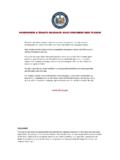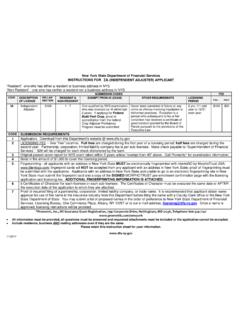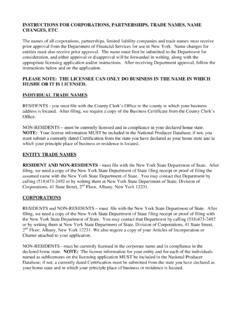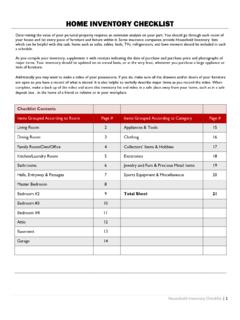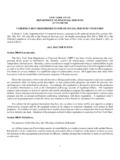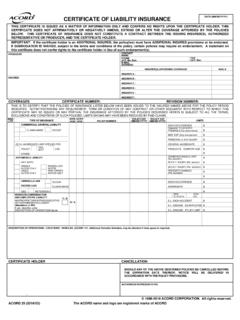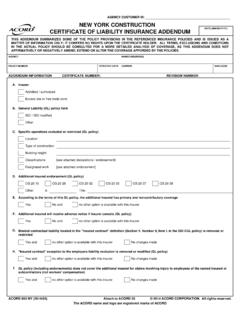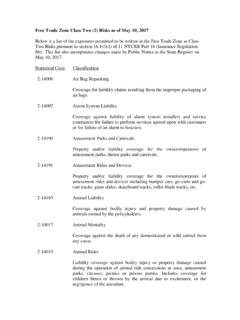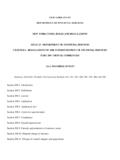Transcription of Superintendent’sRegulations Part504 BANKINGDIVISION ...
1 Department of Financial Services Superintendent's Regulations Part 504. BANKING DIVISION TRANSACTION MONITORING AND FILTERING PROGRAM REQUIREMENTS. AND CERTIFICATIONS. (Statutory authority: Banking Law 37(3)(4); Financial Services Law 302) Sec. Background Definitions Transaction Monitoring and Filtering Program Requirements Annual Certifications Penalties/Enforcement Actions Effective Date Background. The Department of Financial Services (the Department ) has been involved in investigations into compliance by Regulated Institutions, as defined below, with applicable Bank Secrecy Act/Anti . Money Laundering laws and regulations1 ( BSA/AML ) and Office of Foreign Assets Control of the Treasury Department ( OFAC )2 requirements implementing federal economic and trade As a result of these investigations, the Department identified shortcomings in the transaction monitoring and filtering programs of these institutions attributable to a lack of robust governance, oversight, and accountability at senior levels.
2 Based on not only this experience, but also its regular examinations for safety and soundness, along with other factors, the Department has reason to believe that financial institutions have shortcomings in their transaction monitoring and filtering programs. As a result, the Department has determined to clarify the required attributes of a Transaction Monitoring and Filtering Program and to require that the Board of Directors or Senior Officer(s), as applicable, of each Regulated Institution submit to the Superintendent annually a Board 1. With respect to federal laws and regulations, see 31 5311, et seq. and 31 CFR Chapter X. For New York State regulations, see Part 115 (3 NYCRR 115), Part 116 (3 NYCRR 116), Part 416 (3 NYCRR 416) and Part 417 (3.)
3 NYCRR 417). 2. 31 CFR part 501 et seq. 3. For information regarding the Unites States Code, the Code of Federal Regulations and the Federal Register, see Supervisory Policy G 1. Resolution or Compliance Finding, as defined in this Part, confirming the steps taken to ascertain compliance by the Regulated Institution with this Part. This regulation implements these requirements. Definitions. The following definitions apply in this Part: (a) Annual Board Resolution or Senior Officer Compliance Finding means a board resolution or senior officer(s) finding in the form set forth in Attachment A. (b) Bank Regulated Institutions means all banks, trust companies, private bankers, savings banks, and savings and loan associations chartered pursuant to the New York Banking Law (the Banking Law ) and all branches and agencies of foreign banking corporations licensed pursuant to the Banking Law to conduct banking operations in New York.
4 (c) Board of Directors means the governing board of every Regulated Institution or the functional equivalent if the Regulated Institution does not have a Board of Directors. (d) Nonbank Regulated Institutions shall mean all check cashers and money transmitters licensed pursuant to the Banking Law. (e) Regulated Institutions means all Bank Regulated Institutions and all Nonbank Regulated Institutions. (f) Risk Assessment means an on going comprehensive risk assessment, including an enterprise wide BSA/AML risk assessment, that takes into account the institution's size, staffing, governance, businesses, services, products, operations, customers, counterparties, other relations and their locations, as well as the geographies and locations of its operations and business relations; (g) Senior Officer(s) shall mean the senior individual or individuals responsible for the management, operations, compliance and/or risk of a Regulated Institution including a branch or agency of a foreign banking organization subject to this Part.
5 (h) Suspicious Activity Reporting means a report required pursuant to 31 5311 et seq. that identifies suspicious or potentially suspicious or illegal activities. (i) Transaction Monitoring Program means a program that includes the attributes specified in Subdivisions (a), (c) and (d) of Section (j) Filtering Program means a program that includes the attributes specified in Subdivisions (b), (c) and (d) of Section 2. (k) Transaction Monitoring and Filtering Program means a Transaction Monitoring Program, and a Filtering Program, collectively. Transaction Monitoring and Filtering Program Requirements. (a) Each Regulated Institution shall maintain a Transaction Monitoring Program reasonably designed for the purpose of monitoring transactions after their execution for potential BSA/AML violations and Suspicious Activity Reporting, which system may be manual or automated, and which shall include the following attributes, to the extent they are applicable: 1.
6 Be based on the Risk Assessment of the institution; 2. be reviewed and periodically updated at risk based intervals to take into account and reflect changes to applicable BSA/AML laws, regulations and regulatory warnings, as well as any other information determined by the institution to be relevant from the institution's related programs and initiatives; 3. appropriately match BSA/AML risks to the institution's businesses, products, services, and customers/counterparties; 4. BSA/AML detection scenarios with threshold values and amounts designed to detect potential money laundering or other suspicious or illegal activities; 5. end to end, pre and post implementation testing of the Transaction Monitoring Program, including, as relevant, a review of governance, data mapping, transaction coding, detection scenario logic, model validation, data input and Program output; 6.
7 Documentation that articulates the institution's current detection scenarios and the underlying assumptions, parameters, and thresholds; 7. protocols setting forth how alerts generated by the Transaction Monitoring Program will be investigated, the process for deciding which alerts will result in a filing or other action, the operating areas and individuals responsible for making such a decision, and how the investigative and decision making process will be documented; and 8. be subject to an on going analysis to assess the continued relevancy of the detection scenarios, the underlying rules, threshold values, parameters, and assumptions. (b) Each Regulated Institution shall maintain a Filtering Program, which may be manual or automated, reasonably designed for the purpose of interdicting transactions that are prohibited by OFAC, and which shall include the following attributes, to the extent applicable: 1.
8 Be based on the Risk Assessment of the institution; 3. 2. be based on technology, processes or tools for matching names and accounts4, in each case based on the institution's particular risks, transaction and product profiles; 3. end to end, pre and post implementation testing of the Filtering Program, including, as relevant, a review of data matching, an evaluation of whether the OFAC sanctions list and threshold settings map to the risks of the institution, the logic of matching technology or tools, model validation, and data input and Program output; 4. be subject to on going analysis to assess the logic and performance of the technology or tools for matching names and accounts, as well as the OFAC sanctions list and the threshold settings to see if they continue to map to the risks of the institution; and 5.
9 Documentation that articulates the intent and design of the Filtering Program tools, processes or technology. (c) Each Transaction Monitoring and Filtering Program shall require the following, to the extent applicable: 1. identification of all data sources that contain relevant data; 2. validation of the integrity, accuracy and quality of data to ensure that accurate and complete data flows through the Transaction Monitoring and Filtering Program; 3. data extraction and loading processes to ensure a complete and accurate transfer of data from its source to automated monitoring and filtering systems, if automated systems are used; 4. governance and management oversight, including policies and procedures governing changes to the Transaction Monitoring and Filtering Program to ensure that changes are defined, managed, controlled, reported, and audited; 5.
10 Vendor selection process if a third party vendor is used to acquire, install, implement, or test the Transaction Monitoring and Filtering Program or any aspect of it; 6. funding to design, implement and maintain a Transaction Monitoring and Filtering Program that complies with the requirements of this Part; 7. qualified personnel or outside consultant(s) responsible for the design, planning, implementation, operation, testing, validation, and on going analysis of the Transaction Monitoring and Filtering Program, including automated systems if applicable, as well as case management, review and decision making with respect to generated alerts and potential filings; and 4.
